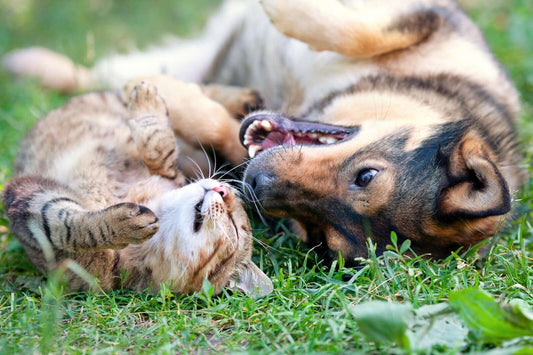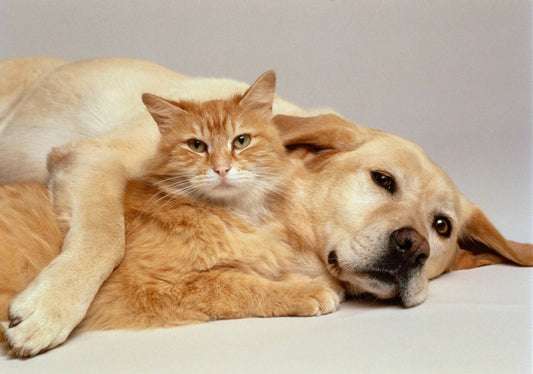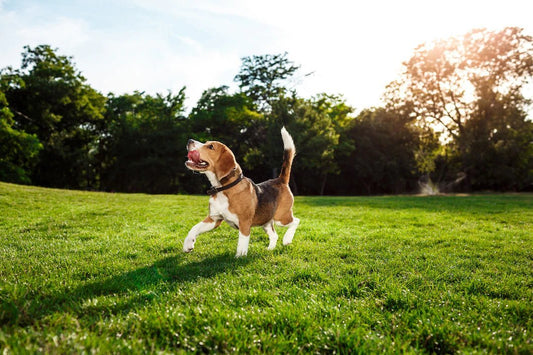Can you picture yourself walking barefoot, exposing your sensitive feet to rough roads, random filth, and harmful debris?
Imagine what your doggos must be going through on their daily walks!
While you could help accessorize your furry friends with a pair of trendy booties, more often than not, your dogs’ paws are going to be exposed to external factors, that may or may not affect their paws.
Sharp debris, fungal infections, ticks, and extreme heat (and extreme cold!), can all harm your dogs while they are out for their daily walks.
Your dog’s paws are hard and tough, to act as protection, and cushion their bones and joints from regular stress. Proper paw health is not simply important, it’s a necessity.

Frequent paw checks and regular grooming should give you an idea about the health of your dog’s paws. In this blog post, we break down a few of the most common dog paw problems that you may encounter, and how to treat them the right way!
9 Common Symptoms to Watch Out For:
- Excessive licking and biting of paws
- Foul smelling paws
- Cysts or growth between paws
- Loss of fur/hair around the paws
- Limping/lameness while walking
- Cracked or excessively dry paws
- Inflamed angry red paws
- Any bleeding or discharge
- Inability to bear any weight on paws
Most Common Causes of Dog Paw Problems:
-
Cracked or Dry Paw Pads: A dog's paw is naturally rough and tough since it acts as a protective barrier from hot streets, cold weather, dirt, and other harmful factors. However, if it gets too dry, then it can lead to dirt and toxic substances getting in through cracked paws, which would further lead to infections and cystic growth. It is recommended to keep their paws clean and moisturized with a healthy paw balm (like the Happy Puppy Organics Paw Balm!). Always thoroughly clean their paws after a walking session and cover their paws with booties if it's too dirty or harsh outside.
-
Paw Burns or Red Inflamed Paws: Dog booties can be of a big help here as well! But if you feel that it is too hot to walk outside barefoot, then it is too hot for your dog's sensitive paws as well. Plan your walks when it gets slightly cooler (essentially avoid any afternoon walks) so that it's comfortable for your doggo. Check your dog's paws regularly for any blisters or burns. If you do notice any redness or a sensitive spot, then contact your vet immediately as paw burns require immediate medical care before it gets infected.
-
Allergies: Yes! Our dogs can have allergies just like humans. Food, chemicals, plants, and insects are common allergens to watch out for. You'd know if your pet has been exposed to an allergen as they would excessively lick, bite and chew at their skin and paws. Regular grooming can help you notice any sudden changes in their skin, ears, and paws. If you do notice any sign of allergy, then your pets need medical attention before they chew and make it worse with bleeding. Some allergens can be extremely toxic to your pets, and it's better to have a veterinarian check your pet out as soon as possible.
-
Long, Ingrown, or Torn Nails: Trimming your pet's nails is an important grooming task, that should not be missed for long periods. Excessively grown nails can cause pain to your pet while walking, as the nail gets pushed back into the paw. Incorrectly cut nails can also cause ingrown nails, which need to be medically treated, and is usually very painful (just as it is for us humans!). A common occurrence with most dogs is their nails being torn as a result of long nails getting stuck in carpets, or while playing with other dogs. Regular trims are a necessity, along with checking for ingrown nails. You could also get them professionally trimmed at a pet grooming salon to avoid trimming them incorrectly.

-
Bacterial and Fungal Infections: The paw pad usually contains a plethora of bacteria and fungi, but at times it can grow out of hand. Common symptoms of infections in dogs are excessive licking, biting, scratching, pulling at their nails, and chewing their paws. Check your pet's skin and paws for signs of infection such as red, inflamed skin, any discharge, foul smell, bumpy skin, and loss of fur. Dry skin, wounds, and allergies can also lead to infection. Your veterinarian will suggest antibiotics and medicated washes until the infection clears.
-
Cuts, Wounds, or Injuries: Cuts and wounds are a common occurrence with dogs, as they may end up jumping from heights, playing with debris, and generally walking outside exposed to several things. If you notice any open wound, do treat it immediately and call your veterinarian for the best care. Be on the lookout for any sharp objects while walking with your dog and do a quick paw check after every outing.
-
Ticks, Mites, and Other Parasites: Ticks have a favourite spot and that’s between the toes of your dogs. If you do notice a tick on your dog, it’s best to have a veterinarian remove it, so you can safely get rid of it, and get some medications for the tick bite (also to prevent tick fever!). Fleas and mites are other parasites that could trouble your pets, and if you doubt your pet has been infested, then do get them tested. You’d know through excessive itching, hair loss, and biting at their skin.
Cysts and Other Growths: Any abnormal growth anywhere on your pet’s body is cause for concern and needs to be medically checked as soon as possible. Some cysts tend to hide between their toes, and thus may be unnoticeable. This is another situation where quick paw checks are necessary.

- Hairy Paws: It is advisable to trim the fur that grows on their paw pads, to reduce getting anything stuck on to their fur while walking. This fur can also be ripped out if caught on something as well. Regular trims and grooming sessions should take care of this problem.
There are many ways to prevent these common paw problems, but there’s only so much you can do. Dogs are active playful beings, and they are going to get into certain mishaps. Regular grooming sessions, nail trims, and cleaning their paws after every walk should keep your pet’s paws happy most of the time.
When in doubt, always call to be sure! If you do doubt that your pet may be experiencing unhappy paws, do book online veterinary consultation with us, and an expert veterinarian will be able to help out within 15 minutes!












